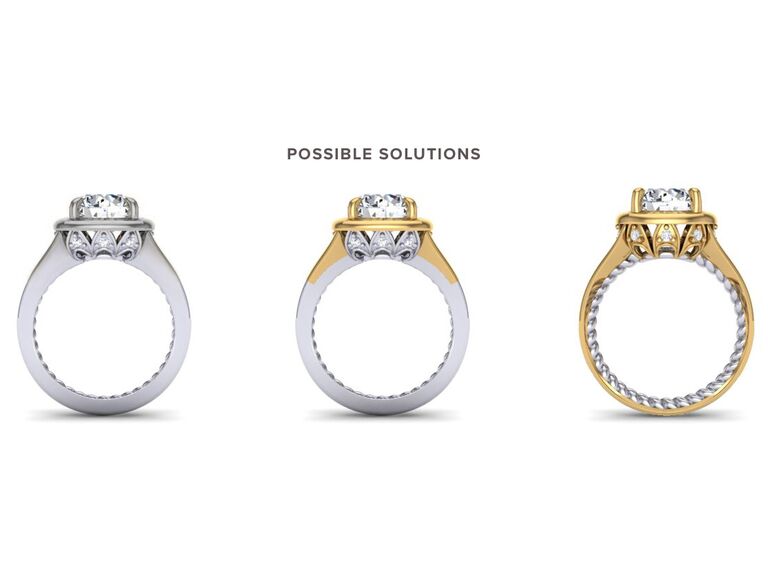No, your finger isn’t necessarily turning green or itchy because your partner bought you a “cheap” ring. Quite the contrary, in fact—some of the highest quality rings could be giving you mysterious allergic reactions. Chief marketing officer of Diamond Nexus Brittany Bozmoski experienced this firsthand when she looked down at her finger one day and noticed a suspicious dark green stain. (Her first thought? “Why is this happening—this is 18K gold!”)
READ MOREDiamonds & Gems: Resetting an Heirloom Stone
Yes, it can happen to anyone, and yes, even if you consider yourself an avid jewelry wearer or diamond expert like Brittany, you’re still totally susceptible to discovering an aversion to an engagement ring after the purchase. Here’s why—and what to do about it.
Gold is almost always mixed with other metals in fine jewelry.
While 24K gold is hypoallergenic, it’s unfortunately too soft to make fine jewelry. Instead, jewelers will take 14K and 18K gold and mix it with other metals like nickel and copper in order to make classic, durable designs. Those metals are likely the reason behind a reaction.
READ MOREDiamonds & Gems: Resetting an Heirloom Stone@media(max-width:768px){#ad-embedded-slot-1-container{min-height:270px}}
Yellow and rose gold are the most likely to cause a reaction.
It’s all about the gold-to-metal ratio—and yellow and rose gold are typically 14 parts gold and 10 parts other metals. (Compare that to 18K gold, which is 18 parts gold and only 6 parts other metals.)
WATCH RELATED VIDEO.jwplayer-main-container-xUmcUqTO{height: 0; padding-bottom: 56.25%;}
Your body’s alkaline levels play a part too.
There isn’t much you can do about a gold allergy, but luckily, it totally depends on your alkaline levels, or the chemical compounds in your body. If your body’s alkaline levels change, so will your reaction to gold. (In other words, it might get better.)
@media(max-width:768px){#ad-embedded-slot-17q4mthin-container{min-height:70px}}
You have options.
If you’re not sure, test it out by rubbing metal on your palm. (FYI—just because you don’t have a reaction to 18K gold doesn’t mean you won’t have a reaction to 14K gold. But if you don’t react to 14K gold, you’re probably fine.)
Already have a ring you love and not sure what to do about your allergy? Take a page from Bozmoski’s book.
“The first thing I did was have the inside of my ring rhodium-plated, which is a hypoallergenic bright silvery finish,” she explains. “It prevents my ring finger from turning green, but it doesn’t stop my pinky finger and middle finger from staining, which is thankfully less noticeable.”
@media(max-width:768px){#ad-embedded-slot-2-container{min-height:270px}}
And even though it’s something you’ll need maintained and re-dipped over the years, it’s a fairly easy process that most jewelers will do for an affordable price. But if you’re looking for a more long-term solution, Bozmoski has your back on that too.
“We’re going to have the ring cast in two pieces—a white gold rope interior band and the external band and head in yellow gold,” she says. “To keep the integrity of the design intact.”
@media(max-width:768px){#ad-embedded-slot-4-container{min-height:70px}}
As of now though, she says she’s “happily living with her temporary solution.” Check it out in the infographic below.
